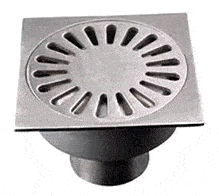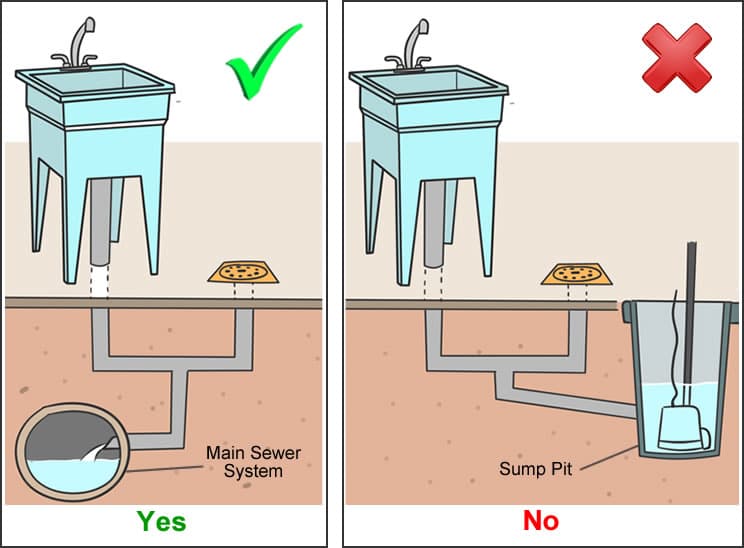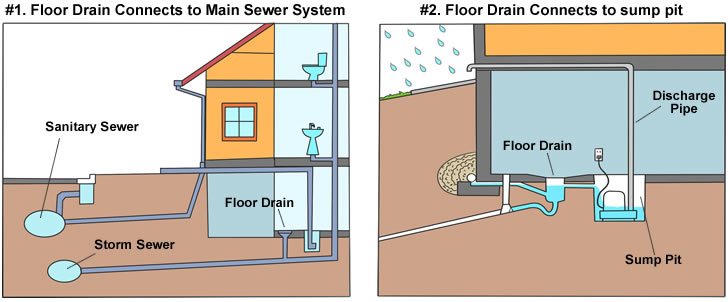The laundry room floor drain is one of those things that you notice, but you don’t pay much attention to until there is a problem.
 The laundry room floor drain is typically a 4-inch round diameter hole located at the lowest point of the room, which is usually installed in the basement floor during the construction phase of a build. The surrounding floor around the drain slopes inwards to help funnel any water from on top of the floor to go in the drain to be removed.
The laundry room floor drain is typically a 4-inch round diameter hole located at the lowest point of the room, which is usually installed in the basement floor during the construction phase of a build. The surrounding floor around the drain slopes inwards to help funnel any water from on top of the floor to go in the drain to be removed.
The floor drain normally has a round or square metal (or cast iron) cover with holes or slots throughout to allow water to pass through and to block other types of objects from falling into the hole.
What Is The Floor Drain For?
A floor drain is generally located at the lowest point of the floor, and it is used to remove standing water which could be caused by a leaking pipe, water heater, furnace, washing machine, water softener, or a sump pump not working correctly.
A floor drain is one of your first lines of defense to help during a flood or faulty piece of equipment.
Is a Floor Drain Required In a Laundry Room?
A lot of people these days are moving their laundry rooms from the basement up to the main or second story floors of their home, where there is currently no floor drain. That makes people ask the question if whether or not they should install a floor drain in the new laundry room location.
Technically a floor drain is not required in the laundry room by code, but you would be silly not to have one. A washing machine can produce up to 40 gallons of water during a regular cleaning cycle. Although a floor drain alone wouldn’t help you avoid water damage with that much water being pumped out, the floor drain would help keep that mess from becoming a huge problem for the rest of the house.
But is a floor drain required if your laundry room is in the basement? Most homes built today are required to have a floor drain in the basement that connects to a sump pit. Water collected in a sump pit is discharged up through a pipe and sent outside of your home to drain away in the foundation. Older homes tend to have still a floor drain that connects directly to a local sewage system.
Why Does My Floor Drain Smell Like a Sewer?
 There are several different reasons why your floor drain might smell like a sewer, but the most likely reason is because of a dried up P-trap that is allowing sewer odors to pass through and into your home.
There are several different reasons why your floor drain might smell like a sewer, but the most likely reason is because of a dried up P-trap that is allowing sewer odors to pass through and into your home.
The P-trap is a U-shaped section of pipe that is designed to hold water to block dangerous sewer gas from rising up and into the home.
Usually, you can fix a dried up P-trap by taking a gallon of water and simply dumping it down into the drain. That will re-prime the P-trap and block out that nasty sewer odor.
If re-priming the P-trap doesn’t do the trick, the sewer smell could be coming from a few other places. I wrote a complete article entitled, Laundry Room Floor Drain Smells, that you might find helpful in finding and fixing the issue.
Can You Drain Washer Into Floor Drain?
Draining a washer into a floor drain depends on where the floor drain connects. For example, if the floor drain connects to a sump pit that discharges the wastewater to the outside of the home, then you can not drain your washing machine into the floor drain.
Now, if your floor drain connects to the main sewer system, then you can connect the washer to the floor drain. But you should keep in mind that the washing machine produces a tremendous amount of water that pumps out at 2 to 3 times faster than an ordinary garden hose. With this much pressure, you could run the risk of having the floor drain overflow.
Ideally, you want to be draining your washing machine into a properly installed standpipe with the correct ventilation to help avoid any overflowing problems.
Can I Connect My Laundry Tub Drain To The Floor Drain?
A laundry tub should only drain to a floor drain when the floor drain connects directly to the main sewer system pipe. You should never have your laundry tub drain into a floor drain that connects to a sump pit. The reason for this is because you don’t ever want to have cleaning products, chemicals or anything else pumping out of a sump pit and onto the property surrounding your home.

Where does the floor drain go to?
In a residential home, there are two possible places where the floor drain goes.
#1. The most common set up in a residential home is that the floor drain connects to a pipe that will remove the wastewater to a main sewer system underground that is shared by other homes in the area, or to a separate septic tank located on the property.
#2. Another possible spot where your floor drain might be connected is to a sump pit located in your home. When the wastewater enters the sump pit and fills up to a certain height, a sump pump will turn on which will begin to pump the wastewater of the sump pit and onto the property draining away from home.

How do you unclog a laundry floor drain?
Clearing a clogged floor drain is fairly simple, and it is something that you can perform on your own, as long as you have the proper tools. The most effective way to unclog a floor drain is by using a flexible auger (plumbers snake) and a drain bladder.
Auger/Bladder
#1. Remove the drain cover and slowly begin to insert the auger down into the drain pipe. Make sure to push it through the P-trap. Pull back and forth a little while you feed the auger through the pipe.
#2. Once you’ve cleared the blockage, remove the auger from the pipe. With any luck, you might pull most of the debris that will attach itself to the auger.
#3. Using an ordinary garden hose, attach the drain bladder to the one end and slide it at least 6 inches down into the pipe. Note: Drain bladders range in different sizes, so make sure that you are using the proper size for your pipe.
#4. Turn the water on all the way. The drain bladder will expand, blocking any air from getting down. Leave this running for about 1 to 2 minutes.
#5. With the water turned off, slowly remove the drain bladder from the pipe by turning it clockwise as you lift it out. (The reason you go clockwise is to make sure that the bladder does not twist off as your pulling it out).
Drano/Liquid Plumber
Alternatively, you can try using either Drano or Liquid Plumber to help break up the blockage. That might help if the clog is in the P-trap.
#1. Choose either Drano or Liquid Plumber (but not both). While wearing protective gloves and goggles, pour your choice of cleaner down into the pipe and let it sit for about 3 – 4 hours.
#2. Take a garden hose and shove it in the pipe as far down as the P-trap. Turn the water on full blast and let it sit for 2 minutes.
If you were not able to unclog the drain pipe using either of the two suggested methods above, then you should have a professional plumber take a look. The clog could be further down in the pipe and require some expertise.
